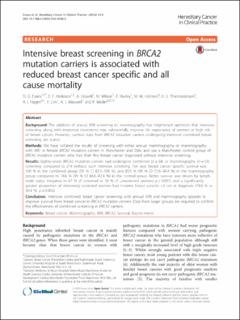| dc.contributor.author | Evans, Dafydd Gareth | |
| dc.contributor.author | Harkness, Elaine F. | |
| dc.contributor.author | Howell, Anthony | |
| dc.contributor.author | Wilson, Mary | |
| dc.contributor.author | Hurley, Emma | |
| dc.contributor.author | Holmen, Marit Muri | |
| dc.contributor.author | Tharmaratnam, Kukatharmini | |
| dc.contributor.author | Hagen, Anne Irene | |
| dc.contributor.author | Lim, Yit Yoong | |
| dc.contributor.author | Maxwell, Anthony James | |
| dc.contributor.author | Møller, Pål | |
| dc.date.accessioned | 2020-03-25T16:00:13Z | |
| dc.date.available | 2020-03-25T16:00:13Z | |
| dc.date.created | 2016-07-15T09:59:36Z | |
| dc.date.issued | 2016 | |
| dc.identifier.citation | Hereditary Cancer in Clinical Practice. 2016, 14 (8) | en_US |
| dc.identifier.issn | 1731-2302 | |
| dc.identifier.uri | https://hdl.handle.net/11250/2648688 | |
| dc.description.abstract | Background
The addition of annual MRI screening to mammography has heightened optimism that intensive screening along with improved treatments may substantially improve life expectancy of women at high risk of breast cancer. However, survival data from BRCA2 mutation carriers undergoing intensive combined breast screening are scarce.
Methods
We have collated the results of screening with either annual mammography or mammography with MRI in female BRCA2 mutation carriers in Manchester and Oslo and use a Manchester control group of BRCA2 mutation carriers who had their first breast cancer diagnosed without intensive screening.
Results
Eighty-seven BRCA2 mutation carriers had undergone combined (n = 34) or mammography (n = 53) screening compared to 274 without such intensive screening. Ten year breast cancer specific survival was 100 % in the combined group (95 % CI 82.5–100 %) and 85.5 % (95 % CI 72.6–98.4 %) in the mammography group compared to 74.6 % (95 % CI 66.6–82.6 %) in the control group. Better survival was driven by lymph node status (negative in 67 % of screened vs 39 % of unscreened women; p < 0.001) and a significantly greater proportion of intensively screened women had invasive breast cancers <2 cm at diagnosis (74.6 % vs 50.4 %; p = 0.002).
Conclusion
Intensive combined breast cancer screening with annual MRI and mammography appears to improve survival from breast cancer in BRCA2 mutation carriers. Data from larger groups are required to confirm the effectiveness of combined screening in BRCA2 carriers. | en_US |
| dc.language.iso | eng | en_US |
| dc.publisher | BioMed Central | en_US |
| dc.rights | Navngivelse 4.0 Internasjonal | * |
| dc.rights.uri | http://creativecommons.org/licenses/by/4.0/deed.no | * |
| dc.title | Intensive breast screening in BRCA2 mutation carriers is associated with reduced breast cancer specific and all cause mortality | en_US |
| dc.type | Peer reviewed | en_US |
| dc.type | Journal article | en_US |
| dc.description.version | publishedVersion | en_US |
| dc.source.volume | 14 | en_US |
| dc.source.journal | Hereditary Cancer in Clinical Practice | en_US |
| dc.source.issue | 8 | en_US |
| dc.identifier.doi | 10.1186/s13053-016-0048-3 | |
| dc.identifier.cristin | 1368121 | |
| dc.description.localcode | Open Access This article is distributed under the terms of the Creative Commons Attribution 4.0 International License (http://creativecommons.org/licenses/by/4.0/), which permits unrestricted use, distribution, and reproduction in any medium, provided you give appropriate credit to the original author(s) and the source, provide a link to the Creative Commons license, and indicate if changes were made. The Creative Commons Public Domain Dedication waiver (http://creativecommons.org/publicdomain/zero/1.0/) applies to the data made available in this article, unless otherwise stated. | en_US |
| cristin.ispublished | true | |
| cristin.fulltext | original | |
| cristin.qualitycode | 1 | |

